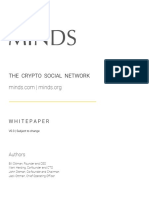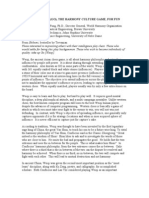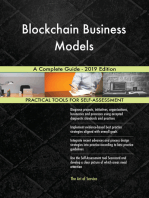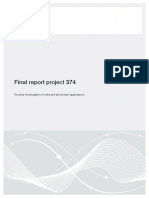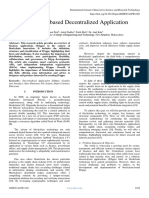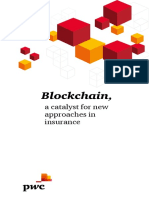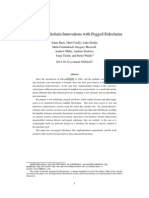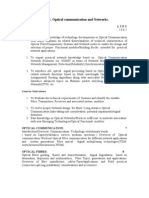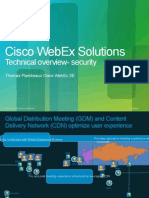Design of The Blockchain Smart Contract: A Use Case For Real Estate
Design of The Blockchain Smart Contract: A Use Case For Real Estate
Uploaded by
Nikos BogonikolosCopyright:
Available Formats
Design of The Blockchain Smart Contract: A Use Case For Real Estate
Design of The Blockchain Smart Contract: A Use Case For Real Estate
Uploaded by
Nikos BogonikolosOriginal Title
Copyright
Available Formats
Share this document
Did you find this document useful?
Is this content inappropriate?
Copyright:
Available Formats
Design of The Blockchain Smart Contract: A Use Case For Real Estate
Design of The Blockchain Smart Contract: A Use Case For Real Estate
Uploaded by
Nikos BogonikolosCopyright:
Available Formats
Journal of Information Security, 2018, 9, 177-190
http://www.scirp.org/journal/jis
ISSN Online: 2153-1242
ISSN Print: 2153-1234
Design of the Blockchain Smart Contract: A Use
Case for Real Estate
Ioannis Karamitsos1, Maria Papadaki2, Nedaa Baker Al Barghuthi2
Rochester Institute of Technology, Dubai, UAE
1
British University of Dubai, Dubai, UAE
2
How to cite this paper: Karamitsos, I., Abstract
Papadaki, M. and Al Barghuthi, N.B. (2018)
Design of the Blockchain Smart Contract: Blockchain is a fast-disruptive technology becoming a key instrument in share
A Use Case for Real Estate. Journal of In- economy. In recent years, Blockchain has received considerable attention
formation Security, 9, 177-190. from many researchers and government institutions. This paper aims to
https://doi.org/10.4236/jis.2018.93013
present the Blockchain and smart contract for a specific domain which is real
Received: April 10, 2018 estate. A detailed design of smart contract is presented and then a use case for
Accepted: June 26, 2018 renting residential and business buildings is examined.
Published: June 29, 2018
Copyright © 2018 by authors and
Keywords
Scientific Research Publishing Inc. Blockchain, Ethereum, Smart Contract, Smart City, Real Estate
This work is licensed under the Creative
Commons Attribution International
License (CC BY 4.0).
http://creativecommons.org/licenses/by/4.0/
1. Introduction
Open Access
In the recent years, there has been an increasing interest in the Blockchain tech-
nology. The Blockchain is a novel disruptive technology based on cryptography.
It has been known of the work of Nakamoto [1] in 2008 who showed how this
technology can become the core component to support transactions of the digi-
tal currency (bitcoin) [2]. With the introduction of Blockchain, many fields such
as finance, accounting, and real estate will receive a positive impact using the
benefits of this technology. One area in which blockchain technology could play
a vital role is real estate and smart cities.
Globally, real estate is undergoing a major evolution and transformation to-
wards smart cities. Smart cities are being developed and a plethora of network,
services, and transactions are integrated into the city planning initially and daily
use. It is anticipated that the evolution of technology, not only improves life, for
example for tenants or office workers, but also enhances building performance
and sustainable energy.
DOI: 10.4236/jis.2018.93013 Jun. 29, 2018 177 Journal of Information Security
I. Karamitsos et al.
The Blockchain is known to be the distributed public ledger for all transac-
tions, eliminating the need of trust between the users and the central adminis-
trator and the control is distributed among different computers/nodes in the
peer-to-peer (P2P) network. Moreover, the Blockchain resolved the double-spend
problem using P2P technology in combination with public/private key crypto-
graphy.
Zhao et al. [3] defined the Blockchain as “a distributed database comprising
records of transactions that are shared among participating parties”. According
to Deloitte [2] [4], Blockchain is “just another type of database for recording
transactions—one that is copied to all computers in a participating network”.
Blockchain by definition is a chain of blocks of information that registers
transactions with some characteristics. Each transaction conducted with Block-
chain technology is registered, time-stamped, and consecutively widely pub-
lished with a unique symbol. Transactions are inserted in the chain of blocks,
and each block is composed by a unique hash function (alphanumeric string re-
sulting from coding data with cryptographic private and public keys), a nonce (a
unique number to the block) and by a hash function from the previous block.
The first block is called genesis block. Therefore, an attempt to forge a block in-
volves the need to forge preceding blocks. This makes the mechanism safe and
secure from attempts to change a transaction.
Many people and researchers believe that blockchain applications in different
vertical industries could lead to three generations of the Blockchain, namely
Blockchain 1.0, Blockchain 2.0 and Blockchain 3.0. The Blockchain 1.0 is the
decentralization of money and payments and is used for digital currency. Fur-
ther, Blockchain 2.0 is used for smart contracts, assets, and properties. It is con-
sidered as the decentralization of finance. Moreover, Blockchain 3.0 is the de-
centralization of the digital society and is used for applications that relate to for
example to the Internet of things (IoT), health and government entities.
This paper discussed the benefits of Blockchain technology applied in the
smart contract for the real estate and smart cities domains. The paper is orga-
nized as follows. In Section 2, the key contribution of the work is presented and
the general introduction of blockchain technology and related work is presented
in Section 3. Blockchain layered approach is presented in Section 4. Section 5 has
discussed the development phases of Blockchain applications. Smart contract
and design methodology were described in Sections 6 and 7. Finally, a used case
for smart cities is examined in Section 8.
2. Key Contributions of Proposed Work
We propose a design methodology for the smart contract which enables devel-
opment of different use cases using Blockchain technology. A detailed state finite
functions and processes are described for a specific use case providing notewor-
thy contributions to real estate domain. In this frame, the blockchain becomes
the enabler for the development of paperless layer for all city transactions, in a
secure fashion for the optimum management of the smart city’s assets. With this
DOI: 10.4236/jis.2018.93013 178 Journal of Information Security
I. Karamitsos et al.
work, the smart contract provides a secure, distributed and shared decentralized
ledger of all assets and transactions between landlord and tenants.
3. Background and Related Work
In its generic form, blockchain technology refers to a fully distributed crypto-
graphically system that captures and stores a consistent, immutable and linear
event log of transactions between networked actors. In such a network, block-
chain technology enforces transparency and guaranteed eventual, system-wide
consensus on the validity of an entire history of transactions. According to
Tschorsch and Scheuermann [5], Blockchain technology can not only process
currency transactions but can also ensure that transactions comply with pro-
grammable rules in the form of “smart contracts”. All these transactions could
be validated between parties who fully trust each other without relying on a
trusted middleman.
Glaser [6] highlights all banks are currently engaged in developing a vision of
what this technology means for their business. Walsh et al. [7] discussed in re-
search and practice that the main parameters for Blockchain implementations
such as security, data privacy, and usability are subject to select the best algo-
rithm to ensure consensus and validity.
Tschorsch and Scheuermann [5], found that proof-of-work approaches that
require high levels of energy but guarantee relatively high levels of consistency
and protection against forgery by any actor in the network (e.g., in Bitcoin)
compete against less costly ones.
Such alternative approaches require a portion of a trust in some elements of
the network, such as actors based on the resources they put at risk during valida-
tion (e.g., proof-of stake) or in the manufacturers of devices that are used to va-
lidate transactions (e.g., proof-of-elapsed time in Hyperledger Sawtooth Lake).
For the design and deployment of Blockchain implementations [8] [9] there
are different parameters that are required to be considered while designing and
deploying the implemented blockchain. The selection criteria are as follows:
Type of consensus mechanism
Programming language
Type of cryptocurrency used for mining
Authorized participant in Blockchain network (who is allowed to participate
in this network)
Tschorsch and Scheuermann [5] investigated the different methods for the va-
lidation and consensus of the transactions providing different balances regarding
availability, consistency, and trustworthiness.
Glaser [6] found that using layered approach for the technical decisions will
provide more different applications for Blockchain technology beyond from the
single cryptocurrency exchanges such as Bitcoin.
Several studies investigate Blockchain technology as a disruptive way for en-
tirely new business models and organization allowing financial transactions with
trustless partners without any additional measures of security.
DOI: 10.4236/jis.2018.93013 179 Journal of Information Security
I. Karamitsos et al.
A number of authors have promoted the vision of a trust-free economy with
truly virtual organizations and automatic business transactions of IoT devices
[8] [9] [10] [11] [12]. Conversely, Atzori [13] argues that the current blockchain
techniques are generally not suitable for IoT applications because IoT devices
may have to work with the low computational capability or very low power and
the validation time is very low as well. The main concern for Blockchain tech-
nology is the efficiency. Blockchain requires a specific validation process to
create a new transaction record which leads to a significant latency of confirma-
tion time and a waste of powerful computing resources. Today the validation
time for each transaction such as Bitcoin is about 10min achieving 7 transac-
tions/sec as the maximum throughput.
Some researchers have attempted to improve the efficiency of the Blockchain.
Zyskind et al. [14] proposed a lightweight decentralized blockchain data man-
agement architecture to protect the personal data and ensures users own and
control their data. The proposed method improves the efficiency by using
off-chain data storage.
Precisely, the authors implemented a protocol that turns a blockchain into
an automated access-control manager that does not require trust in the third
party.
Paul et al. [15] proposed a new method that improves the energy efficiency in
Bitcoin. The authors added some extra bytes in the present header field to utilize
the timestamp more effectively.
Blockchain technology platforms can be programmed into two types public
and private as depicted in the following Table 1.
Public (Permissionless) fully public blockchain where anyone can read and
write.
Private (Permissioned) blockchain which allows defining different permis-
sions on different users on the network. There can be different permissions
for different operations on the blockchain.
Blockchain with smart contracts enabled into it such as the capability of
building business logic and business process mechanism into the chain. Typ-
ical examples are Ethereum or Hyperledger Fabric.
Blockchain with cryptocurrency transactions. This is only being deployed for
transaction capabilities transferring an amount of value from one account to
another. Typical examples are Bitcoin or Multi-Chain.
It is apparent from Table 1 that the two Blockchain types (public or pri-
vate) is very important decision parameter for the smart contract implemen-
tations.
Table 1. Network types of blockchain.
Public Blockchain Private Blockchain
With Smart Contract Ethereum Ethereum/Hyperledger
With Cryptocurrency Transaction Bitcoin Multichain
DOI: 10.4236/jis.2018.93013 180 Journal of Information Security
I. Karamitsos et al.
For the public Blockchain, the block validation/mining includes reward me-
chanisms to incentivize miners to verify and validate transactions. To date, the
reward amount is about 0.25 BTC for each transaction. On the other hand, for
the private group Blockchain implementations are more focus on permissioning
mechanisms that allow for granting participation rights to accountable and
identifiable participants while denying them access to others rather incentivize
mining mechanisms.
4. Blockchain Layered Approach
The technological components underlying the Blockchain layers include trans-
actions, block, consensus, applications and smart contract. All these components
are separated into different layers which are equivalent to the blockchain eco-
system. The key aspects of blockchain can be divided into six layers listed as fol-
lows: network, transaction, the blockchain, trust, application and security layers.
Each of these layers has different properties and characteristics as shown in the
following Figure 1. The network layer refers to P2P network with Ethereum or
Hyperledger nodes.
The transaction layer refers to transactions triggered by the users or smart
contract. The Blockchain layer has used to refer to the block status containing all
the necessary information whereas the trust layer refers to the consensus proto-
col for the block and transactions validation.
The application layer encompasses applications, state machine, and smart
contract. This layer is always separated from the blockchain layer with the smart
contract to be the most important component as will be discussed in the follow-
ing section 6. The security layer is very vital for the Blockchain technology. The
blockchain technology is vulnerable to many types of attacks such as eclipse, sel-
fish mining and 51% attack. The 51% attack is the most cited attack on the
blockchain.
Owner Blockchain as a Service (BaaS) Users
Smart Contract Development Front-End Apps Back-End Apps dApp
Application Layer
Security and Governance Layer
Consensus algorithms Proof based Fault Tolerant based
Trust Layer
Private
Public Blockchain Blocks validation
Blockchain
Blockchain Layer
Transactions Validation Mining
Transaction Layer
Virtual Storage P2P Ethereum/
Servers network Hyperledger
Network Layer Nodes
Figure 1. Proposed Illustration of Blockchain layers.
DOI: 10.4236/jis.2018.93013 181 Journal of Information Security
I. Karamitsos et al.
A “51%” attack is still possible for an attacker that controls less than half of
the network hash rate. But in this case, the probability of success depends on
what percentage of the hash rate the attacker controls and the number of blocks.
Only when the attacker controls > 50% of the network hash rate is possible of
success 100% [13]. This node then can dominate all other nodes modify the
records in the blockchain.
Yli-Humuto et al. [16] and Lim et al. [17] performed a security analysis that found
many security breaches have occurred including DDOS and private account hack-
ing. Atzori [1] found that privacy and confidentiality are still open problems with
Blockchain because all the Blockchain nodes are shared with access to all data.
5. Development Phases of Blockchain Applications
For the design and implementation of the Blockchain applications the following
phases such as analysis, design, and implementation are presented in the follow-
ing Figure 2.
Analysis Phase Design Phase Implementation Phase
Figure 2. Development phases for blockchain applications.
In the analysis phase, we collect and analyze the requirements of the block-
chain application to be developed. Identify the entities/parties involved, their
roles and relationships. The entities can be physical (assets or users) or virtual
(such as concepts).
In the design phase, we model the entity attributes as state variables and inte-
ractions between them as functions. In addition, we captured the constraints and
dependencies.
In the implementation phase, we implement the smart contract for the block-
chain applications. The main components of the smart contract are state va-
riables, functions, modifiers, and events in a high-level programming language
such as Solidity. In the next sections, we described the smart contract in details.
If a user interface friendly is required then the DApp implementation is manda-
tory as we described in the next section.
Decentralized Applications (DApps)
A Decentralized Application (DApp) is an application that uses smart contracts
providing a friendly user interface to smart contracts. A typical example of
DApp is a cryptocurrency application that runs on a blockchain network. A De-
centralized application structure is composed by a front-end interface (Web
Browser, HTML, CSS) and a back-end interface (Web3 JavaScript). As described
in Figure 3, the DApp application interacts with the Ethereum node (EVM) us-
ing JSON RPC. JSON RPC is a stateless and lightweight remote procedure call
(RPC) protocol that is used by Ethereum clients to interact with an Ethereum node.
DOI: 10.4236/jis.2018.93013 182 Journal of Information Security
I. Karamitsos et al.
Dapp
Front-end
BLOCKCHAIN BLOCKCHAIN
USERS Web Browser USERS
Back-end
HTML/CSS/JS
Web3.js
RPC Ethereum Node
Ethereum Virtual Machine (EVM)
Figure 3. DApp structure.
For the development of the Decentralized application (DApp) the following
steps are required:
Design and implement smart contract in a high-level language (Solidity).
Compile the contract to generate a binary file.
Deploy the contract on Ethereum Blockchain network using Ethereum
clients (Geth, PyEthApp).
Build a Web application (Front-end) that interact with the smart contracts.
For this use case, the blockchain technology requires two parts:
An Ethereum smart contract using Solidity as the programming language
which resides on the Ethereum Virtual Machine (EVM) block.
A Distributed App (DApp) composed by front-end and back-end applica-
tions in which interacts with the smart contract and the users (landlord/real
estate owner and tenants).
6. Smart Contract Structure
Back to 1997, Nick Szabo [18] has introduced the term “smart contract”. A
smart contract is a code program identified by an address in the Blockchain
network. The main components of the smart contract are a set of executable
functions and state variables. Each transaction has input parameters which are
required a function in the contract. During the execution of a function, the sta-
tus of the state variables is changed depending on the logic implementation.
The smart contract code is written in high-level languages such as Solidity and
Python for Ethereum applications. The code is compiled into bytecode using
compilers as Solidity or Serpent. The contract code will be uploaded into the
Blockchain network once the compiler is executed without any errors. Each
contract will be assigned a unique address by the Blockchain network.
Any user in the Blockchain network can trigger the functions of sending any
DOI: 10.4236/jis.2018.93013 183 Journal of Information Security
I. Karamitsos et al.
kind of transactions. The contract code is executed on each node member in the
Blockchain network as a part of their verification of new blocks.
Smart contracts deployed on a Blockchain network can send messages to oth-
er contracts. The message is composed by the address of the sender, the address
of recipient, value of transfer, and a data field which contains the input data to
the recipient contract. There is a difference between message and transaction, in
which transaction is produced by External Owned Account (EOA) while the
message is produced by a smart contract as shown in Figure 4.
Figure 4. Smart contract structure.
Ethereum is one of the preferred technologies for the development of the
smart contracts. The main components for the transactions are based on state
machine and functions. It is a Turing-complete contract processing and execu-
tion platform based of a Blockchain decentralized shared ledger. The design and
the implementation of the Ethereum are totally independently from the crypto-
currency Bitcoin. A high-level programming language called Solidity is used to
write smart contracts and decentralized applications (Dapps). The programmer
can create their transactions formats, state transitions and events functions, and
rules for ownership. The software code is executed on virtual machine referred
to as the Ethereum Virtual Machine (EVM) [19].
7. Design Methodology for Smart Contract
The design methodology for the smart contract is composed by the following
steps. First, for any users the setup of the Ethereum nodes is required; second,
the business services/functions are defined and finally, the processes between the
users are described. In the following sections, the above steps are presented in
details.
7.1. Ethereum Node Setup
The components of the Ethereum node are actors, roles, business services and
processes as described in the following Figure 5.
7.1.1. Actors and Roles
For the definition of smart contract, we need to design the application template
which is one-to-many users. The actors for the smart contract are as follows:
The Contract Owner usually is landlord or real estate owner who is responsible
for the development of the smart contract and external owned account (EOA).
DOI: 10.4236/jis.2018.93013 184 Journal of Information Security
I. Karamitsos et al.
Figure 5. Proposed rental system-use case components.
Users/Tenants who are responsible for the creation of their Ethereum Wal-
lets in order to have access in the public/private blockchain P2P nodes.
7.1.2. Business Services-Functions
The business services and functions that required for the smart contract are the
following:
Create transaction;
Create smart contracts;
Send messages;
Mine Ether or BTC.
7.1.3. Ethereum Processes
For the Ethereum platform, we have four processes which are:
Block Validation: This process is for validating block.
Network Discovery: This process is necessary for a new node to join the P2P
Blockchain network.
Transaction Creation: It allows users to create transactions and allows smart
contracts to create events and messages.
Mining: This process describes the mining process and broadcasting a new
block to the network.
8. Use case: Smart Contract for Real Estate
For this use case, the Ethereum Blockchain platform is selected. The real estate
acts as landlord for the properties which requires renting a number of residential
and business properties using blockchain technology as shown in Table 2.
In the next sections, we described the phases for the smart contract develop-
ment in which consist of analysis, design, and implementation phases.
DOI: 10.4236/jis.2018.93013 185 Journal of Information Security
I. Karamitsos et al.
Table 2. Real estate use case.
Type of Blockchain Private Blockchain Network
Services offering Renting Residential/Business Properties
8.1. Analysis Phase
During the analysis phase, a collection of requirements from different personas
into the organization are required. Then a set of workshops are developed to
understand how the blockchain technology and smart contracts can provide
benefits in the organization and identify the actors, roles, and responsibilities.
Actors/Roles
Externally Owned Accounts (EOA): The Landlord and Tenants as consi-
dered as external owned accounts. These accounts are controlled by private keys.
This actor can create transactions to transfer value, create smart-contracts or call
contract functions.
Contract Accounts (CA): These accounts are controlled by their own code.
Every time it receives a message, its code executes, allowing it to read and write
to internal storage and send messages to other contracts or create contracts in
return.
Miners: They validate the transactions and blocks. The transactions are
wrapped into a block and a proof-of-work will be provided for this block. After
validating the transaction into the block, an amount is provided to miners as a
reward. For the specific use case, we have selected private Blockchain then the
mining is not required since the parties are already known and trusted.
8.2. Design Phase
After identifying the entities and set up the accounts, the design of the smart
contract will be developed. The main components of the smart contract as we
had described in the previous Section 6 are functions, processes, state variables,
events, and transactions.
8.2.1. Real Estate Smart Contract Functions
The smart contract is between a landlord/real estate owner and tenants. The
purpose of the contract is to make sure that the rental agreement is signed, the
rental amount is paid on time, and the termination of the contract is executed
correctly. The following describes the smart contract functions:
Functions-Created: The Landlord initiates the contract by setting up the
rental terms and the details of landlord and tenants. After that, the state of the
contract is set to “CREATED”.
Functions-Started: Tenant signs the contract and rent begins and the state of
the tenant is set to “STARTED” when the state is “STARTED”, the rental agree-
ment cannot be confirmed again, thus eliminating the possibility of overwriting
the current tenant.
DOI: 10.4236/jis.2018.93013 186 Journal of Information Security
I. Karamitsos et al.
Functions-Rent Collection: The smart contract collects rent from the tenants
and sends it to the landlord. This is a powerful feature of this contract to makes
it “SMART”.
Functions-Terminated: When the Landlord terminates the contract, the state
set to “TERMINATED” and all balance deposit is sent to the tenant after check-
ing the status of the property.
8.2.2. Real Estate Smart Contract Processes
For this use case, the process is one-to-many parties and the definition of the
processes is described as follows:
1) Rent Contract Signature Process
In this process, as shown in Figure 6, both parties sign the smart contract
(rental agreement) which include in details the rental value, payment frequency,
and landlord and tenant’s details.
2) Rental Payments Process
This process is based on terms and conditions of the rental agreement. The
smart contract initiates the lease payments from the tenants to landlord and FM
contractors using different mode of payments as depicted in Figure 7.
Tenants
Real Estate Owner
Rental Contract
Agreement between
parties
Tenants
Landlord
.......
Tenants
Figure 6. Process rent contract “signature”.
Real Estate Owner
$$ $$
Rental Payments Tenants
Landlord
$$ .......
$$
Tenants
FM Contractors
Figure 7. Process rent contract “payments”.
DOI: 10.4236/jis.2018.93013 187 Journal of Information Security
I. Karamitsos et al.
3) Termination Rent Contract Process
This process is on the termination rental as shown in Figure 8. The smart
contract triggers the payment of security deposit back to tenants after checking
and adjusting any damage repair charges.
$$ Tenants
Real Estate Owner
$$
$$ Security deposit
Termination of
Landlord
Rental contract Tenants
.......
$$
Tenants
Figure 8. Process rent contract “termination”.
8.3. Implementation Phase
In the implementation phase, the code programming for the smart contract is
started using Solidity. Functions and processes are defined in the design phase
and translated into code program. The content of the smart contract is shown in
the following Figure 9.
Figure 9. Implementation of the real estate smart contract.
DOI: 10.4236/jis.2018.93013 188 Journal of Information Security
I. Karamitsos et al.
9. Conclusion & Future Work
This paper has presented an overview of the Blockchain technology as a disrup-
tive technology for real estate industry. This study was designed to determine the
effect of smart contract with the various components for the implementation.
Real Estate development should assess whether and when Blockchain can be
used as a technology in their organization. For the adoption of Blockchain into
the organization, it is important to meet certain requirements in order to im-
prove the efficiency of the current processes. Perhaps Blockchain technology did
not cover the whole process in their organization, however, the cost/benefits
analysis should be prepared once the smart cities owner identifies a process that
is ready for Blockchain technology.
The benefits of using smart contract and blockchain technology for real estate
are as follows:
Different parties can modify database: In the real estate ecosystem, mul-
tiple parties such as owners, tenants, and financial management (FM) opera-
tors involve the management of real estate properties. They have access to
modify a variety of information with the Blockchain. This eliminates the
modification between the parties.
Trustless among entities and parties: During the real estate development,
different entities might not have any business relationships previously. Thus,
this might increase the lack of trust.
Advantage of Disintermediation: With the Blockchain, trusted intermedia-
tors such as notary and brokers are not required since the transactions can be
independently verified and automatically validated.
Transactions advantage: In real estate companies, different transactions re-
lated to different parties (such as landlords, tenants and FM services) are part
of the same database. The real estate companies face difficulties to separate
the number of invoices. With the Blockchain technology, we can separate
transactions between the parties seeking to improve the efficiency of the in-
voicing process. As an example, in the net rent lease structure, the tenant
pays the facility services (such as cooling and maintenance services) directly
to the FM companies and the base rent amount directly to the landlord.
A state finite function and process work is presented in details. Future work
needs to assess the impact of the different platform such as Hyperledger Fabric
for the specific use case presented in this paper.
References
[1] Nakamoto, S. (2018) Bitcoin: A Peer-to-Peer Electronic Cash System.
https://bitcoin.org/bitcoin.pdf
[2] Deloitte. (2016) What Is Blockchain?
https://www2.deloitte.com/content/dam/Deloitte/uk/Documents/Innovation/deloitt
e-uk-what-is-blockchain-2016.pdf
[3] Zhao, J.L., Fan, S. and Yan, J. (2016) Overview of Business Innovations and Re-
search Opportunities in Blockchain and Introduction to the Special Issue. Financial
DOI: 10.4236/jis.2018.93013 189 Journal of Information Security
I. Karamitsos et al.
Innovation, 2, 28. https://doi.org/10.1186/s40854-016-0049-2
[4] Deloitte. (2017) A New Game Changer for the Media Industry?
https://www2.deloitte.com/content/dam/Deloitte/tr/Documents/technology-media-
telecommunications/deloitte-PoV-blockchain-media.pdf
[5] Tschorsch, F. and Scheuermann, B. (2016) Bitcoin and Beyond: A Technical Survey
on Decentralized Digital Currencies. IEEE Communication Survey Tutorial, 18,
2084-2123. https://doi.org/10.1109/COMST.2016.2535718
[6] Glaser, F. (2017) Pervasive Decentralisation of Digital Infrastructures: A Framework
for Blockchain Enabledsystem and Use Case Analysis. 50th Hawaii International
Conference on System Sciences (HICSS 2017), Waikoloa, Hawaii, USA, 1-14.
[7] Walsh, C., Reilly, P.O., Gleasure, R., Feller, J., Li, S. and Cristoforo, J. (2016) New
Kind on the Block: A Strategic Archetypes Approach to Understanding the Block-
chain. 37th International Conference on Information Systems, Dublin, 1-12.
[8] Beck, R., Stenum Czepluch, J., Lollike, N. and Malone, S. (2016) Blockchain the Ga-
teway to Trust-Free Cryptographic Transactions. 24th European Conference on In-
formation Systems, Istanbul, Turkey, 1-14.
[9] Christidis, K. and Devetsikiotis, M. (2016) Blockchains and Smart Contracts for the
Internet of Things. IEEE Access, 4, 2292-2303.
https://doi.org/10.1109/ACCESS.2016.2566339
[10] Puschmann, T. and Alt, R. (2016) Sharing Economy. Business & Information Sys-
tems Engineering, 58, 93-99. https://doi.org/10.1007/s12599-015-0420-2
[11] Glaser, F. and Bezzenberger, L. (2015) Beyond Cryptocurrencies—A Taxonomy of
Decentralized Consensus Systems. 23rd European Conference on Information Sys-
tems, Munster, 1-18.
[12] Glaser, F., Zimmermann, K., Haferkorn, M., Webe, M.C. and Siering, M. (2014)
Bitcoin—Asset or Currency? Revealing Users’ Hidden Intentions. 22th European
Conference on Information Systems, Tel Aviv, 9-11 June 2014, 1-14.
[13] Atzori, M. (2015) Blockchain Technology and Decentralized Governance: Is the
State Still Necessary? https://doi.org/10.2139/ssrn.2709713
[14] Zyskind, G., Nathan, O. and Pentland, A. (2015) Decentralizing Privacy: Using
Blockchain to Protect Personal Data. IEEE Security and Privacy Workshops, San
Jose, 180-184.
[15] Paul, G., Sarkar, P. and Mukherjee, S. (2014) Towards a More Democratic Mining
in Bitcoins. In: Prakash, A. and Shyamasundar, R., Eds., Information Systems Secu-
rity, Vol. 8880 of Lecture Notes in Computer Science, Springer International Pub-
lishing, Berlin, 185-203.
[16] Yli-Huumo, J., Ko, D., Choi, S., Park, S. and Smolander, K. (2016) Where Is Current
Research on Blockchain Technology? A Systematic Review. PLoS ONE, 11,
e0163477. https://doi.org/10.1371/journal.pone.0163477
[17] Lim, I.K., Kim, Y.H., Lee, J.G., Lee, J.P., Nam-Gung, H. and Lee, J.K. (2014) The
Analysis and Countermeasures on Security Breach of Bitcoin. In: International
Conference on Computational Science and Its Applications, Springer International
Publishing, Berlin, 720-732. https://doi.org/10.1007/978-3-319-09147-1_52
[18] Szabo, N. (1997) Formalizing and Securing Relationships on Public Networks. First
Monday, 2, No. 9. http://firstmonday.org/ojs/index.php/fm/article/view/548/469
[19] Buterin, V. (2015) On Public and Private Blockchains. Ethereum Blog, Crypto Re-
naissance Salon. 7th August 2015.
DOI: 10.4236/jis.2018.93013 190 Journal of Information Security
You might also like
- Echameleon Manual V8-3Document123 pagesEchameleon Manual V8-3EBD100% (2)
- Pclaw 10: User GuideDocument364 pagesPclaw 10: User GuideHaroon RashidNo ratings yet
- Kickpad WhitepaperDocument15 pagesKickpad WhitepaperBÙI NGUYÊN LUẬN - VIOLYMPIC TOÁNNo ratings yet
- White Paper: "Beyond The Crypto Headlines: Understanding The Full Story"Document6 pagesWhite Paper: "Beyond The Crypto Headlines: Understanding The Full Story"joeNo ratings yet
- Mastering Blockchain by Imran Bashir b01nbbspcdDocument6 pagesMastering Blockchain by Imran Bashir b01nbbspcdThenmozhi50% (4)
- Minds WhitepaperDocument34 pagesMinds WhitepaperVictor Mariano LeiteNo ratings yet
- The Social Smart ContractDocument27 pagesThe Social Smart ContractCésar G. Rincón GonzálezNo ratings yet
- White PaperDocument35 pagesWhite PaperDidik PrasetyaNo ratings yet
- Maecenas WhitePaperDocument19 pagesMaecenas WhitePaperSamNo ratings yet
- Bitcoin & Cryptocurrencies Guide: Introduction Learn Everything You Need To Know!From EverandBitcoin & Cryptocurrencies Guide: Introduction Learn Everything You Need To Know!Rating: 2 out of 5 stars2/5 (1)
- Seminar Report BlockDocument18 pagesSeminar Report BlockFieldartNo ratings yet
- Real Estate's Embrace of Digital Transformation - Centric DigitalDocument14 pagesReal Estate's Embrace of Digital Transformation - Centric Digitalananth999No ratings yet
- RES Holdings Limited - Annual Report 2018Document120 pagesRES Holdings Limited - Annual Report 2018AlezNgNo ratings yet
- The 10 Fastest Growing Economies of The Next 40 Years Mar 11Document5 pagesThe 10 Fastest Growing Economies of The Next 40 Years Mar 11Genevieve Goveas LoboNo ratings yet
- DragonBiteWhitePaper 8c67Document61 pagesDragonBiteWhitePaper 8c67hotaro orekiNo ratings yet
- 000 Disruptive Potential of Real Estate Crowdfunding in The Real Estate Project Finance IndustryDocument28 pages000 Disruptive Potential of Real Estate Crowdfunding in The Real Estate Project Finance Industryeman talaatNo ratings yet
- Ey Industrializing Blockchain in AseanDocument17 pagesEy Industrializing Blockchain in AseanVarun MittalNo ratings yet
- ZEROPAY WhitepaperDocument15 pagesZEROPAY WhitepaperIlham NurrohimNo ratings yet
- Zeus Consulting SaDocument12 pagesZeus Consulting SaAdy NugrahaNo ratings yet
- MIT Digital Currency Initiative: Working Group Research PaperDocument38 pagesMIT Digital Currency Initiative: Working Group Research Paperflor_14895No ratings yet
- Learn Weiqi (Go), The Harmony Culture Game, For FunDocument9 pagesLearn Weiqi (Go), The Harmony Culture Game, For FunFRANCIS FUNGNo ratings yet
- Byzantine Generals Problem PDFDocument42 pagesByzantine Generals Problem PDFJonhatan Alberto Lopez GautoNo ratings yet
- EU Blockchain Ecosystem Report - Final - 0Document200 pagesEU Blockchain Ecosystem Report - Final - 0Vitaliy Che KogoNo ratings yet
- Time EnergyDocument7 pagesTime EnergyFarooq Bin MahfoozNo ratings yet
- Terracoin Step by Step Masternode Tutorial For Windows UsersDocument8 pagesTerracoin Step by Step Masternode Tutorial For Windows UserslamalamicNo ratings yet
- Blockchain Business Models A Complete Guide - 2019 EditionFrom EverandBlockchain Business Models A Complete Guide - 2019 EditionNo ratings yet
- Safemoon: Static Rewards LP Acquisition Manual BurnDocument7 pagesSafemoon: Static Rewards LP Acquisition Manual BurnBÙI NGUYÊN LUẬN - VIOLYMPIC TOÁNNo ratings yet
- November 2019 American ConsequencesDocument74 pagesNovember 2019 American Consequencesgalt67No ratings yet
- Final Report Project 374: Security Investigation of Selected Blockchain ApplicationsDocument47 pagesFinal Report Project 374: Security Investigation of Selected Blockchain ApplicationsDominic SummersNo ratings yet
- Block Chain SyllabusDocument2 pagesBlock Chain SyllabusAsim IqbalNo ratings yet
- Blockchain in USADocument34 pagesBlockchain in USASubhamNo ratings yet
- Blockchain Based Decentralized ApplicationDocument7 pagesBlockchain Based Decentralized ApplicationInternational Journal of Innovative Science and Research TechnologyNo ratings yet
- Blockchain A CatalystDocument44 pagesBlockchain A CatalystsankhaNo ratings yet
- Wave Financial - Harmony Cross-Fi Research ReportDocument45 pagesWave Financial - Harmony Cross-Fi Research ReportTomNo ratings yet
- Algorand's Layer 1 Strategy-2Document5 pagesAlgorand's Layer 1 Strategy-2tompascalNo ratings yet
- Introduction To BlockchainDocument12 pagesIntroduction To BlockchainShreyNo ratings yet
- Solana Blockchain Development - MobiloitteDocument1 pageSolana Blockchain Development - MobiloitteMobiloitte TechnologiesNo ratings yet
- Winning in Growth Cities: A Cushman & Wakefield Global Capital Markets ReportDocument54 pagesWinning in Growth Cities: A Cushman & Wakefield Global Capital Markets ReportCheungWaiChungNo ratings yet
- Rentberry Whitepaper enDocument59 pagesRentberry Whitepaper enKen Sidharta0% (1)
- Bondar - Stablecoins From Electronic Money On Blockchain To A Cryptocurrency Basket PDFDocument97 pagesBondar - Stablecoins From Electronic Money On Blockchain To A Cryptocurrency Basket PDFДмитрий БондарьNo ratings yet
- Prospects of Using Blockchain in Banking Sectors of BangladeshDocument85 pagesProspects of Using Blockchain in Banking Sectors of BangladeshranjohnsarkershuvoNo ratings yet
- NFT Arts Research Paper - Ariana Schrader-RankDocument20 pagesNFT Arts Research Paper - Ariana Schrader-RankCreedNo ratings yet
- ZENIQ PresentationDocument35 pagesZENIQ PresentationBernie M. SemommungNo ratings yet
- Startup Cities - A New Approach To Reform PDFDocument26 pagesStartup Cities - A New Approach To Reform PDFAdriana PeraltaNo ratings yet
- Side ChainsDocument25 pagesSide ChainsMichaelPatrickMcSweeneyNo ratings yet
- Blockchain & Africa's Transformation QuestionDocument14 pagesBlockchain & Africa's Transformation QuestionMuhammed MoshoodNo ratings yet
- KPMG Sfa The Asset Tokenization C Suite PlaybookDocument26 pagesKPMG Sfa The Asset Tokenization C Suite PlaybookKommu RohithNo ratings yet
- Tokenized Money Through Smart Contract 2023Document36 pagesTokenized Money Through Smart Contract 2023tamlqNo ratings yet
- Block Chain and The Token EconomyDocument409 pagesBlock Chain and The Token Economyliauda100% (1)
- NFT - Legal Token Classification: About This ReportDocument14 pagesNFT - Legal Token Classification: About This ReportThe HijackerNo ratings yet
- Indexed Pseudo CodeDocument21 pagesIndexed Pseudo CodeNikhil GoelNo ratings yet
- Blockchain Whitepaper PDFDocument16 pagesBlockchain Whitepaper PDFmustafa.ahmetNo ratings yet
- Sundaeswap Fundamentals: 1 BackgroundDocument12 pagesSundaeswap Fundamentals: 1 BackgroundJose A. P. ContrerasNo ratings yet
- Telehouse Cold Calling Script - Channel Partners: Probing QuestionsDocument1 pageTelehouse Cold Calling Script - Channel Partners: Probing Questionsjohn labuNo ratings yet
- Crypto Crime Report 2022Document140 pagesCrypto Crime Report 2022kittycat55No ratings yet
- Emerging Stablecoins Latest DevelopmentsDocument28 pagesEmerging Stablecoins Latest DevelopmentsAthanasios TsagkadourasNo ratings yet
- Reimagining IndiaDocument4 pagesReimagining IndiaKushal BathijaNo ratings yet
- Blockchain Distributed Ledger Technologies For Biomedical and Health Care ApplicationsDocument10 pagesBlockchain Distributed Ledger Technologies For Biomedical and Health Care ApplicationsMatias CaporaleNo ratings yet
- Blockchain White Paper PDFDocument49 pagesBlockchain White Paper PDFfallNo ratings yet
- Dogecoin 3.0 Whitepaper V1 - DOGE3.0Document7 pagesDogecoin 3.0 Whitepaper V1 - DOGE3.0dogecoincoin310No ratings yet
- ICO MARKET RESEARChDocument64 pagesICO MARKET RESEARChGungaa JaltsanNo ratings yet
- 100 Telecommunication and Switching Systems MCQs With AnswersDocument26 pages100 Telecommunication and Switching Systems MCQs With AnswersQweku TeyeNo ratings yet
- Gnana Padmesh Internship ReportDocument32 pagesGnana Padmesh Internship Reportsec20it019No ratings yet
- Instructions 5Document55 pagesInstructions 5Razvan KalavrezosNo ratings yet
- Program Non-Revenue Water (NRW) Nasional Pendekatan 1 - Negeri Kedah Dan Perlis Approach & MethodologyDocument13 pagesProgram Non-Revenue Water (NRW) Nasional Pendekatan 1 - Negeri Kedah Dan Perlis Approach & MethodologydinNo ratings yet
- Routers Software Configuration Guide (Cisco 826, 827, 828, 831, 836, and 837 and Cisco SOHO 76, 77, 78, 91, 96, and 97)Document248 pagesRouters Software Configuration Guide (Cisco 826, 827, 828, 831, 836, and 837 and Cisco SOHO 76, 77, 78, 91, 96, and 97)Ronald CornejoNo ratings yet
- An Encryption Protocol For End-To-End Secure Transmission of SMSDocument7 pagesAn Encryption Protocol For End-To-End Secure Transmission of SMSThet Hmue Hay ThiNo ratings yet
- Cisco Ransomware Defense Validated Design GuideDocument72 pagesCisco Ransomware Defense Validated Design GuideKristine AbanadorNo ratings yet
- SSP 24.10.0.155 - Additional Information - Service ProjectDocument2 pagesSSP 24.10.0.155 - Additional Information - Service ProjectotatiservicesNo ratings yet
- IEC 61850 Solutions SubstationDocument3 pagesIEC 61850 Solutions SubstationStevan NestorovNo ratings yet
- CP0963 SybDocument2 pagesCP0963 SybNishant PatelNo ratings yet
- MidTerm SolutionDocument4 pagesMidTerm Solutionmahmoud sobhiNo ratings yet
- Cisco WebEx SecurityDocument23 pagesCisco WebEx SecurityjawajuiceNo ratings yet
- Fibrolan Ds3100r0108 H.conmaDocument2 pagesFibrolan Ds3100r0108 H.conmaTed Pelas JohanssonNo ratings yet
- CSE X Max Technology ReportDocument10 pagesCSE X Max Technology ReportRushda ShaikNo ratings yet
- CV SalemDocument2 pagesCV SalemsalemNo ratings yet
- HP Flexfabric 11900 Switch Series: Product OverviewDocument2 pagesHP Flexfabric 11900 Switch Series: Product OverviewwefreNo ratings yet
- DHI-NVR1108HS-W-S2: 8 Channel Compact 1U 1HDD Network Video RecorderDocument3 pagesDHI-NVR1108HS-W-S2: 8 Channel Compact 1U 1HDD Network Video RecorderGuido Ojalvo TorrezNo ratings yet
- Bio Data Abhishek Chandrashekhar BarveDocument3 pagesBio Data Abhishek Chandrashekhar BarveAbhishek BarveNo ratings yet
- CBCS M.Sc. Computer ScienceDocument11 pagesCBCS M.Sc. Computer ScienceAyushNo ratings yet
- Panther Edr 2Document12 pagesPanther Edr 2Felipe FantinelNo ratings yet
- Smartie: A Security Solution For A Smart City Using Internet of Things - Architecture Reference ModelDocument6 pagesSmartie: A Security Solution For A Smart City Using Internet of Things - Architecture Reference ModelKhyati Zalawadia100% (2)
- COMPUTER NOTES FinalDocument50 pagesCOMPUTER NOTES FinalOpoka John ModiNo ratings yet
- Exámen 77200X ResueltoDocument23 pagesExámen 77200X ResueltoFelipe Ospina OspinaNo ratings yet
- A. M. Jain CollegeDocument29 pagesA. M. Jain CollegeRamanujam O SNo ratings yet
- Computer Buses and InterfacesDocument34 pagesComputer Buses and InterfacesSholeh FirmansyahNo ratings yet
- HOPPERJET - Network Reconnaissance Framework Tool - ReportDocument39 pagesHOPPERJET - Network Reconnaissance Framework Tool - ReportMSV ForeverNo ratings yet
- Mtcloud ComputingDocument27 pagesMtcloud ComputingfalakinachanNo ratings yet
- U Max 070530Document27 pagesU Max 070530Emmanuel ValiaoNo ratings yet





